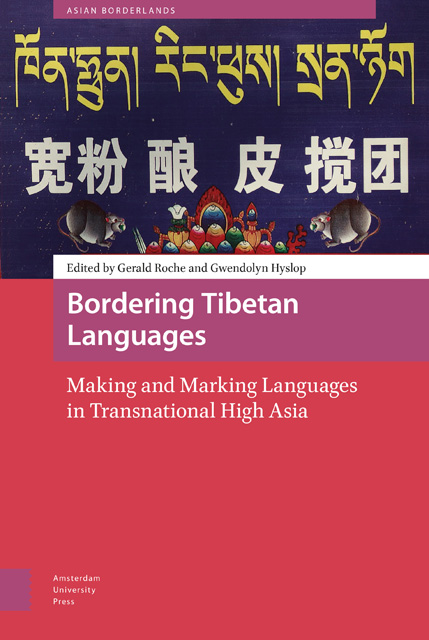Book contents
- Frontmatter
- Table of Contents
- Acknowledgements
- About the Cover Image
- 1 Introduction: Bordering Tibetan Languages: Making and Marking Languages in Transnational High Asia
- 2 Playing with Language Boundaries: Heteroglot Standard Language Ideology and Linguistic Belonging among Amdo Children
- 3 The Role of Classical Tibetan (Chöke) on the Development of Kurtöp, a Language of Bhutan
- 4 Reimagining Rongring without Tibetan Buddhist Influence
- 5 Glottonyms, Identity, and Language Recognition in the Eastern Tibetosphere
- 6 On the Yak Horns of a Dilemma: Diverging Standards in Diaspora Tibetan
- 7 Changing Identity and Linguistic Practices in Nubri: Veiled Language Endangerment in the Nepalese Tibetosphere
- 8 Borderline Dominance: Transnational Tibetan Language Politics in the Himalayas
- 9 Borders: In Conclusion
- Tibetan Language Summaries
- Asian Borderlands
- Index
1 - Introduction: Bordering Tibetan Languages: Making and Marking Languages in Transnational High Asia
Published online by Cambridge University Press: 24 November 2022
- Frontmatter
- Table of Contents
- Acknowledgements
- About the Cover Image
- 1 Introduction: Bordering Tibetan Languages: Making and Marking Languages in Transnational High Asia
- 2 Playing with Language Boundaries: Heteroglot Standard Language Ideology and Linguistic Belonging among Amdo Children
- 3 The Role of Classical Tibetan (Chöke) on the Development of Kurtöp, a Language of Bhutan
- 4 Reimagining Rongring without Tibetan Buddhist Influence
- 5 Glottonyms, Identity, and Language Recognition in the Eastern Tibetosphere
- 6 On the Yak Horns of a Dilemma: Diverging Standards in Diaspora Tibetan
- 7 Changing Identity and Linguistic Practices in Nubri: Veiled Language Endangerment in the Nepalese Tibetosphere
- 8 Borderline Dominance: Transnational Tibetan Language Politics in the Himalayas
- 9 Borders: In Conclusion
- Tibetan Language Summaries
- Asian Borderlands
- Index
Summary
Abstract
This chapter explores the relationship between language borders and state borders. It argues that both state and language borders are forms of structural violence that are mutually reinforcing. These interlocking forms of structural violence produce material, biopolitical, and representational inequalities and concrete harms. Therefore, like the placing of state borders, the placing of language borders is seen to be a non-trivial issue. The transnational Himalayas, stretching across the People's Republic of China (PRC), Pakistan, India, Nepal, and Bhutan, are introduced as an ideal site for investigating how language and state borders interact. Furthermore, the role that Tibetan, as an imagined language, plays in the region is seen to have central importance to this dynamic.
Keywords: borders, languages, Tibet, Himalaya
Languages and borders
It is both widely agreed and frequently observed that the borders of nation states and languages do not match. This seemingly straightforward claim is sometimes made to celebrate and valorize linguistic diversity within a state, or to critique the fantasy of the linguistically homogeneous nation state where linguistic and political borders seamlessly align. What this claim leaves unexamined, however, is language borders themselves. It takes language borders to be precisely what they are not: natural, apolitical, and uncontested.
This book examines where, how, and by whom linguistic borders are drawn. It looks at how language borders interact with other borders, particularly state borders, and how these interactions impact people's lives. In particular, we examine the negative effects that language borders produce as a form of structural violence (Galtung, 1969; Farmer, 2004).
This focus on borders, particularly state borders, as sites of violence, has become particularly pronounced in recent years, in the context of rising populism and exclusionary nationalism, as well as numerous border crises around the world: the 2015 European migrant crisis; Brexit and the looming border with Northern Ireland; the ongoing tragedies and travesties of Australian border ‘protection’; the persecution of Rohingya in Myanmar and their flight across the border to Bangladesh and India; the detention camps on the US-Mexico border; border conflicts between India and China cross the Himalaya; and ongoing efforts to parse citizens and foreigners in India, to name but a few.
- Type
- Chapter
- Information
- Bordering Tibetan LanguagesMaking and Marking Languages in Transnational High Asia, pp. 11 - 30Publisher: Amsterdam University PressPrint publication year: 2022



